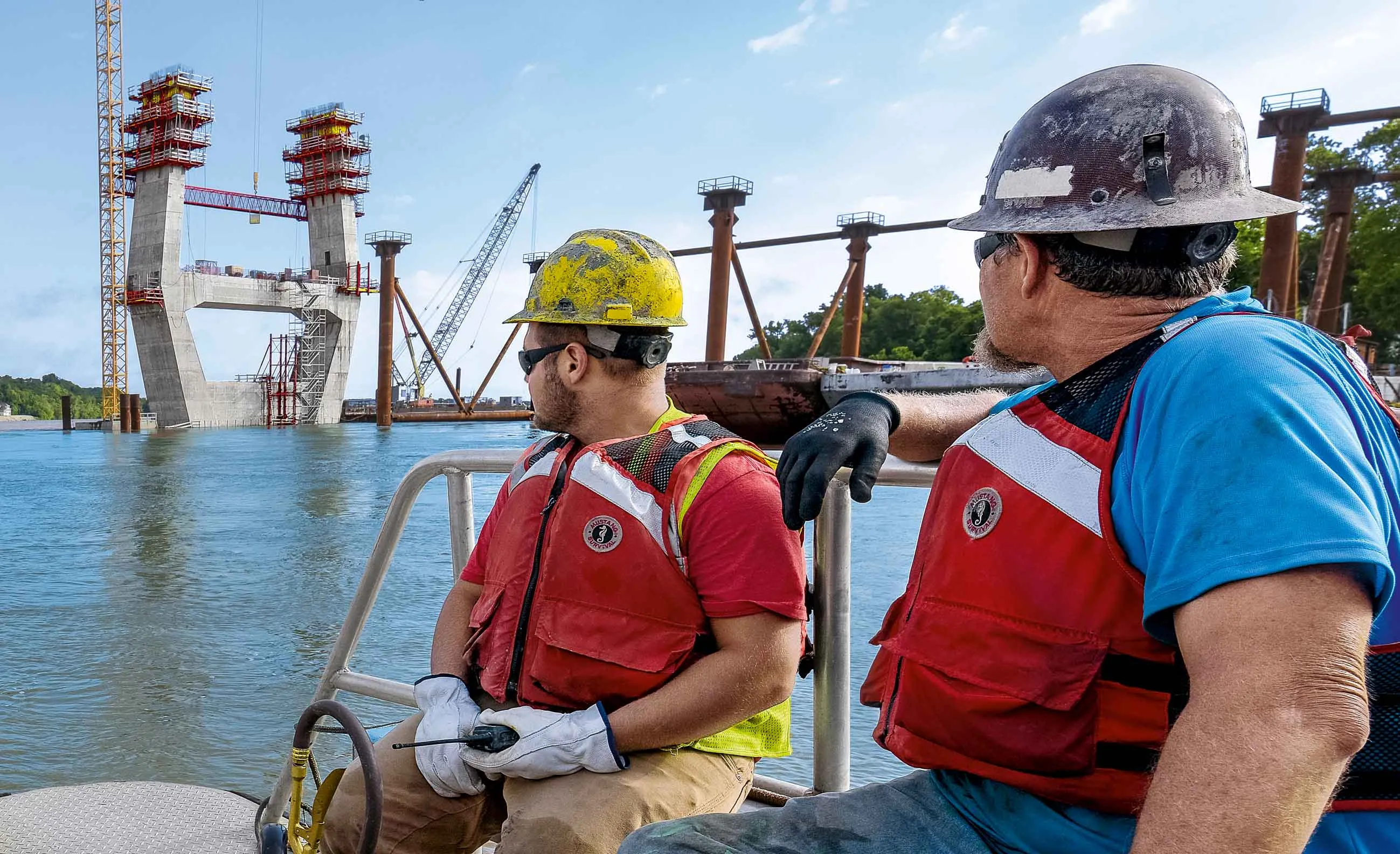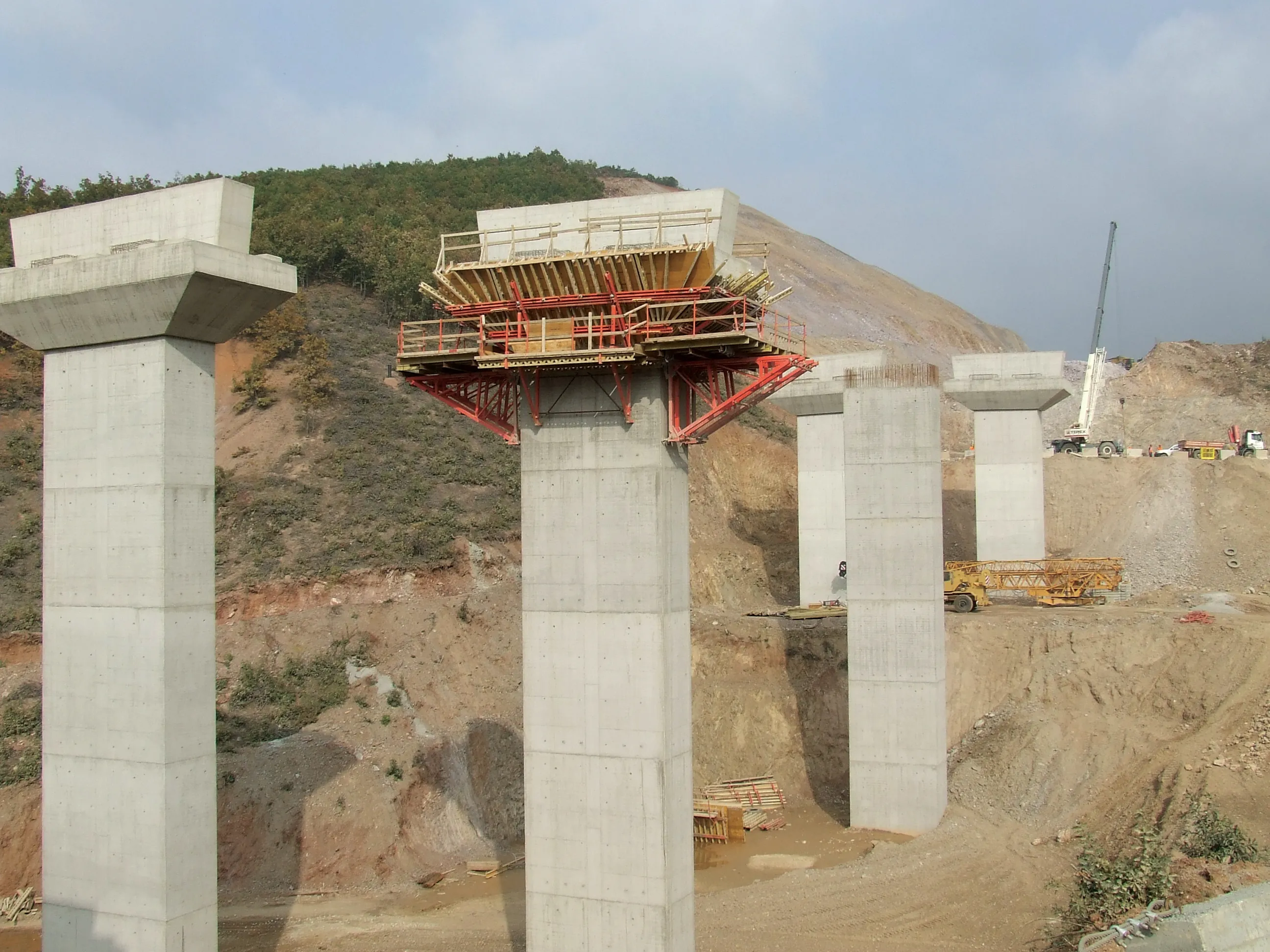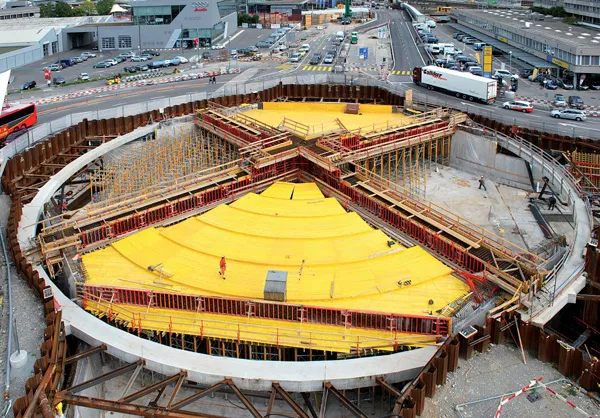Pylons almost 90m high are a striking feature of a new cable-stayed East End Crossing bridge over the Ohio River in Louisville, Kentucky state in the US
The pylons are characterised by their complex shapes and massive legs and cross beams. Peri provided a comprehensive overall concept for its construction – consisting of a planning solution with perfectly matched formwork, climbing, shoring and scaffolding systems along with extensive on-site support.
With a Peri solution, the construction crew were a
July 6, 2016
Read time: 5 mins

Pylons almost 90m high are a striking feature of a new cable-stayed East End Crossing bridge over the Ohio River in Louisville, Kentucky state in the US
The pylons are characterised by their complex shapes and massive legs and cross beams.298 Peri provided a comprehensive overall concept for its construction – consisting of a planning solution with perfectly matched formwork, climbing, shoring and scaffolding systems along with extensive on-site support.
With a Peri solution, the construction crew were able to build the two bridge pylons in Louisville within the specified construction period and with low dimension tolerances.
The 762m-long bridge connects the states of Kentucky and Indiana and is part of the nearly 14km-long Louisville-Southern Indiana Ohio River Bridge Project. The project offers possibilities for the river crossing and thereby counteracting congestion problems in the region. Through the project, among other things, the Interstate 64 highway has been rerouted to the north of Louisville
The span of the main bridge section reaches 365m and the carriageway is carried by means of stay cables supported by two reinforced concrete pylons each 90m high. The lower part of the pylon legs inclines outwards and is designed as a solid construction. Above the carriageway, the pylon legs incline inwards and feature hollow box cross sections.
In the process, the cross sections taper upwards and have a slight curvature caused by a continuous change in the angle of inclination from casting segment to casting segment. Two 3.65m-thick cross beams connect the pylon legs – one at road surface level and the other at the upper pylon reinforcement. This meant that each construction section presented a specific challenge not only regarding the geometry but also in terms of load transfer.
In addition, it was important to find the optimal formwork solution in the area of boxes for accommodating the stay cables.
A German-American Peri project team developed and delivered a complete solution for the individual construction sections. A number of formwork and scaffolding systems from the extensive Peri rental pool were used. The variable Vario GT 24 Girder Wall Formwork, is a combination of ACS, RCS and SCS Self Climbing Formwork, heavy-duty shoring on the basis of the Variokit Engineering Construction Kit.
Peri UP Scaffolding was combined with the Vario GT 24 to ensure fast cycle sequences, high load bearing capacities and a maximum level of safety during all stages of construction.
The pylons were divided into five construction sections: the outwardly inclined and tapering lower section of the massive pylon legs were followed by the hollow box cross beams at the level of the carriageway as the second section. The following inwardly inclining and likewise tapering part of the pylon leg in turn was again divided into two sections as the boxes for the stay cables at the top of the pylons had to be integrated. The upper cross beam for reinforcement of the pylon formed the fifth and final phase of execution.
Due to the tremendous differences in the individual construction stages, each area required separate new sets of formwork and scaffolding. The lower pylon legs were built in four casting segments, each around 18m high. As the concrete required prolonged curing time, Peri provided two sets of formwork per pylon leg which were used by the construction team implementing the so called leapfrog process. By means of custom connections at the corners, the formwork could be easily adapted to suit the extreme inclinations as well as the tapered sections.
Through the use of appropriate reinforcement featuring system components from the Variokit Engineering Construction Kit, the formwork was sufficiently strengthened so that the concreting loads from the reversed inclined areas could be transferred into the foundations.
The "knuckles" in the pylon leg required a particularly tricky solution whereby the lower cross beam was also to be accommodated. Construction of this area took nearly four months.
The formwork for the hollow cross beams – also built using Variokit system components – was supported on six VST Heavy Duty Shoring Towers. Each tower held a load-bearing capacity of over 270tonnes. The use of mobile hydraulics on the head spindles guaranteed easy striking.
While cross beam work was in progress, work began on the third section – the further rising pylon legs. The RCS Rail Climbing System was used on the inside of the hollow construction while the ACS Self Climbing System raised the Vario formwork on the outside.
The combination of climbing systems speeded up construction while crane requirements were kept to a minimum.
Through the planned possibility of dividing the climbing formwork in construction section number four (the upper area of the pylon), installation of the steel stay anchor boxes could be carried out without interruption to formwork and concreting operations. For the final cross beam of the pylon at a height of around 90m, formwork featuring Variokit components was planned, pre-assembled and flown in according to the construction progress.
By pre-assembling the formwork sets in the Peri rental facility south of Chicago, on-site assembly time was minimised.
Walsh/Vinci construction consortium also commissioned Peri to incorporate insulation between the girders of the Vario GT 24 Wall Formwork. As a result, concreting operations continued throughout the winter and without any loss of time.
The bridge is expected to be open by the end of this year.
The pylons are characterised by their complex shapes and massive legs and cross beams.
With a Peri solution, the construction crew were able to build the two bridge pylons in Louisville within the specified construction period and with low dimension tolerances.
The 762m-long bridge connects the states of Kentucky and Indiana and is part of the nearly 14km-long Louisville-Southern Indiana Ohio River Bridge Project. The project offers possibilities for the river crossing and thereby counteracting congestion problems in the region. Through the project, among other things, the Interstate 64 highway has been rerouted to the north of Louisville
The span of the main bridge section reaches 365m and the carriageway is carried by means of stay cables supported by two reinforced concrete pylons each 90m high. The lower part of the pylon legs inclines outwards and is designed as a solid construction. Above the carriageway, the pylon legs incline inwards and feature hollow box cross sections.
In the process, the cross sections taper upwards and have a slight curvature caused by a continuous change in the angle of inclination from casting segment to casting segment. Two 3.65m-thick cross beams connect the pylon legs – one at road surface level and the other at the upper pylon reinforcement. This meant that each construction section presented a specific challenge not only regarding the geometry but also in terms of load transfer.
In addition, it was important to find the optimal formwork solution in the area of boxes for accommodating the stay cables.
A German-American Peri project team developed and delivered a complete solution for the individual construction sections. A number of formwork and scaffolding systems from the extensive Peri rental pool were used. The variable Vario GT 24 Girder Wall Formwork, is a combination of ACS, RCS and SCS Self Climbing Formwork, heavy-duty shoring on the basis of the Variokit Engineering Construction Kit.
Peri UP Scaffolding was combined with the Vario GT 24 to ensure fast cycle sequences, high load bearing capacities and a maximum level of safety during all stages of construction.
The pylons were divided into five construction sections: the outwardly inclined and tapering lower section of the massive pylon legs were followed by the hollow box cross beams at the level of the carriageway as the second section. The following inwardly inclining and likewise tapering part of the pylon leg in turn was again divided into two sections as the boxes for the stay cables at the top of the pylons had to be integrated. The upper cross beam for reinforcement of the pylon formed the fifth and final phase of execution.
Due to the tremendous differences in the individual construction stages, each area required separate new sets of formwork and scaffolding. The lower pylon legs were built in four casting segments, each around 18m high. As the concrete required prolonged curing time, Peri provided two sets of formwork per pylon leg which were used by the construction team implementing the so called leapfrog process. By means of custom connections at the corners, the formwork could be easily adapted to suit the extreme inclinations as well as the tapered sections.
Through the use of appropriate reinforcement featuring system components from the Variokit Engineering Construction Kit, the formwork was sufficiently strengthened so that the concreting loads from the reversed inclined areas could be transferred into the foundations.
The "knuckles" in the pylon leg required a particularly tricky solution whereby the lower cross beam was also to be accommodated. Construction of this area took nearly four months.
The formwork for the hollow cross beams – also built using Variokit system components – was supported on six VST Heavy Duty Shoring Towers. Each tower held a load-bearing capacity of over 270tonnes. The use of mobile hydraulics on the head spindles guaranteed easy striking.
While cross beam work was in progress, work began on the third section – the further rising pylon legs. The RCS Rail Climbing System was used on the inside of the hollow construction while the ACS Self Climbing System raised the Vario formwork on the outside.
The combination of climbing systems speeded up construction while crane requirements were kept to a minimum.
Through the planned possibility of dividing the climbing formwork in construction section number four (the upper area of the pylon), installation of the steel stay anchor boxes could be carried out without interruption to formwork and concreting operations. For the final cross beam of the pylon at a height of around 90m, formwork featuring Variokit components was planned, pre-assembled and flown in according to the construction progress.
By pre-assembling the formwork sets in the Peri rental facility south of Chicago, on-site assembly time was minimised.
Walsh/Vinci construction consortium also commissioned Peri to incorporate insulation between the girders of the Vario GT 24 Wall Formwork. As a result, concreting operations continued throughout the winter and without any loss of time.
The bridge is expected to be open by the end of this year.








